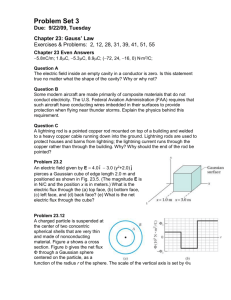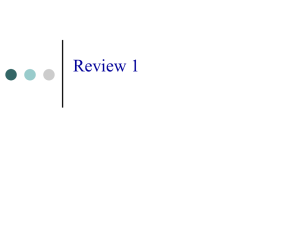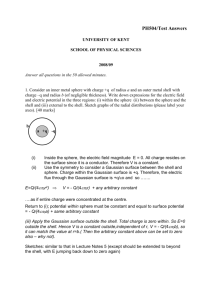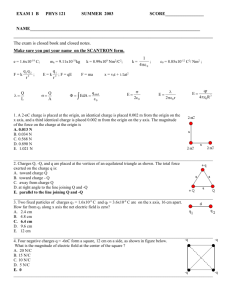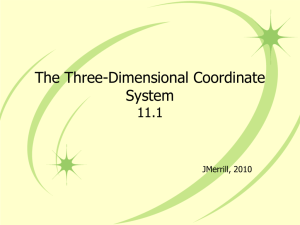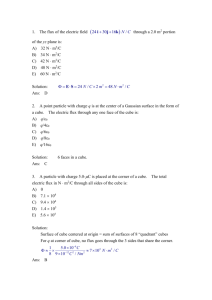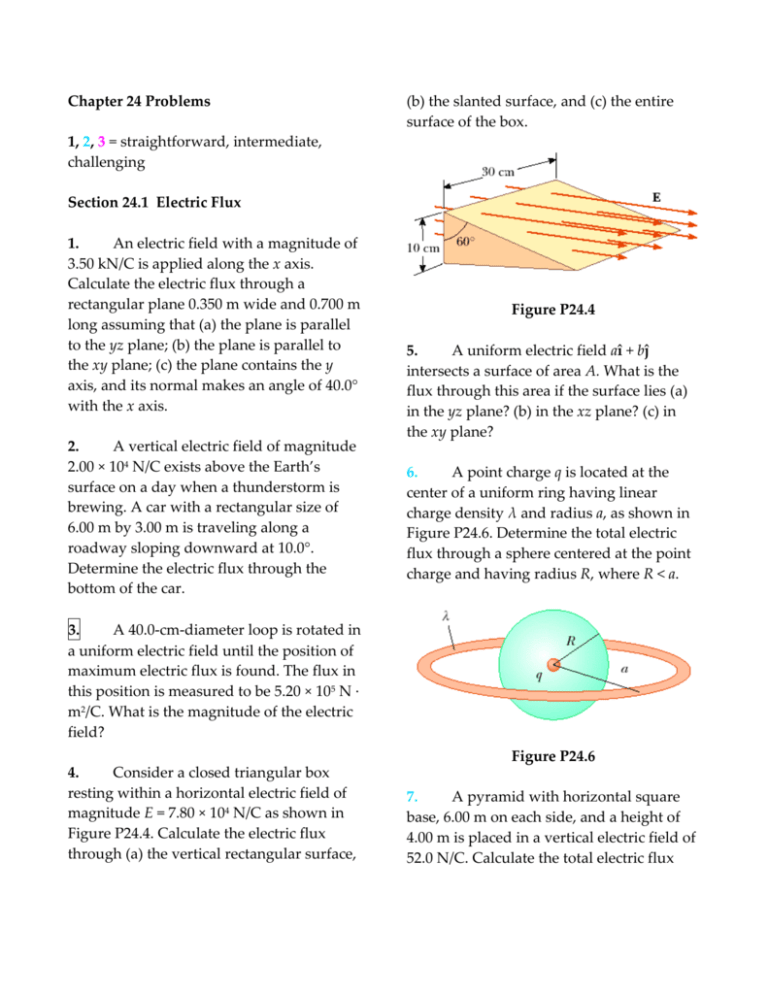
Chapter 24 Problems
(b) the slanted surface, and (c) the entire
surface of the box.
1, 2, 3 = straightforward, intermediate,
challenging
Section 24.1 Electric Flux
1.
An electric field with a magnitude of
3.50 kN/C is applied along the x axis.
Calculate the electric flux through a
rectangular plane 0.350 m wide and 0.700 m
long assuming that (a) the plane is parallel
to the yz plane; (b) the plane is parallel to
the xy plane; (c) the plane contains the y
axis, and its normal makes an angle of 40.0°
with the x axis.
2.
A vertical electric field of magnitude
2.00 × 104 N/C exists above the Earth’s
surface on a day when a thunderstorm is
brewing. A car with a rectangular size of
6.00 m by 3.00 m is traveling along a
roadway sloping downward at 10.0°.
Determine the electric flux through the
bottom of the car.
Figure P24.4
5.
A uniform electric field aî + bĵ
intersects a surface of area A. What is the
flux through this area if the surface lies (a)
in the yz plane? (b) in the xz plane? (c) in
the xy plane?
6.
A point charge q is located at the
center of a uniform ring having linear
charge density λ and radius a, as shown in
Figure P24.6. Determine the total electric
flux through a sphere centered at the point
charge and having radius R, where R < a.
3.
A 40.0-cm-diameter loop is rotated in
a uniform electric field until the position of
maximum electric flux is found. The flux in
this position is measured to be 5.20 × 105 N ·
m2/C. What is the magnitude of the electric
field?
Figure P24.6
4.
Consider a closed triangular box
resting within a horizontal electric field of
magnitude E = 7.80 × 104 N/C as shown in
Figure P24.4. Calculate the electric flux
through (a) the vertical rectangular surface,
7.
A pyramid with horizontal square
base, 6.00 m on each side, and a height of
4.00 m is placed in a vertical electric field of
52.0 N/C. Calculate the total electric flux
through the pyramid’s four slanted
surfaces.
8.
A cone with base radius R and
height h is located on a horizontal table. A
horizontal uniform field E penetrates the
cone, as shown in Figure P24.8. Determine
the electric flux that enters the left-hand
side of the cone.
11.
Four closed surfaces, S1 through S4,
together with the charges –2Q, Q, and –Q
are sketched in Figure P24.11. (The colored
lines are the intersections of the surfaces
with the page.) Find the electric flux
through each surface.
Figure P24.8
Section 24.2 Gauss’s Law
9.
The following charges are located
inside a submarine: 5.00 μC, –9.00 μC, 27.0
μC, and –84.0 μC. (a) Calculate the net
electric flux through the hull of the
submarine. (b) Is the number of electric
field lines leaving the submarine greater
than, equal to, or less than the number
entering it?
10.
The electric field everywhere on the
surface of a thin spherical shell of radius
0.750 m is measured to be 890 N/C and
points radially toward the center of the
sphere. (a) What is the net charge within
the sphere’s surface? (b) What can you
conclude about the nature and distribution
of the charge inside the spherical shell?
Figure P24.11
12.
(a) A point charge q is located a
distance d from an infinite plane. Determine
the electric flux through the plane due to
the point charge. (b) What If? A point
charge q is located a very small distance
from the center of a very large square on the
line perpendicular to the square and going
through its center. Determine the
approximate electric flux through the
square due to the point charge. (c) Explain
why the answers to parts (a) and (b) are
identical.
13.
Calculate the total electric flux
through the paraboloidal surface due to a
uniform electric field of magnitude E0 in the
direction shown in Figure P24.13.
the average volume charge density in the
layer of air between these two elevations? Is
it positive or negative?
Figure P24.13
14.
A point charge of 12.0 μC is placed at
the center of a spherical shell of radius 22.0
cm. What is the total electric flux through
(a) the surface of the shell and (b) any
hemispherical surface of the shell? (c) Do
the results depend on the radius? Explain.
17.
A point charge Q = 5.00 μC is located
at the center of a cube of edge L = 0.100 m.
In addition, six other identical point
charges having q = –1.00 μC are positioned
symmetrically around Q as shown in Figure
P24.17. Determine the electric flux through
one face of the cube.
15.
A point charge Q is located just
above the center of the flat face of a
hemisphere of radius R as shown in Figure
P24.15. What is the electric flux (a) through
the curved surface and (b) through the flat
face?
Figure P24.17
Figure P24.15
16.
In the air over a particular region at
an altitude of 500 m above the ground the
electric field is 120 N/C directed
downward. At 600 m above the ground the
electric field is 100 N/C downward. What is
18.
A positive point charge Q is located
at the center of a cube of edge L. In
addition, six other identical negative point
charges q are positioned symmetrically
around Q as shown in Figure P24.17.
Determine the electric flux through one face
of the cube.
19.
An infinitely long line charge having
a uniform charge per unit length λ lies a
distance d from point O as shown in Figure
P24.19. Determine the total electric flux
through the surface of a sphere of radius R
centered at O resulting from this line
charge. Consider both cases, where R < d
and R > d.
electric flux through each of the sides of the
cube which meet at the point a.
Figure P24.22
Figure P24.19
Section 24.3 Application of Gauss’s Law
to Various Charge Distributions
20.
An uncharged nonconducting
hollow sphere of radius 10.0 cm surrounds
a 10.0-μC charge located at the origin of a
cartesian coordinate system. A drill with a
radius of 1.00 mm is aligned along the z
axis, and a hole is drilled in the sphere.
Calculate the electric flux through the hole.
23.
Determine the magnitude of the
electric field at the surface of a lead-208
nucleus, which contains 82 protons and 126
neutrons. Assume the lead nucleus has a
volume 208 times that of one proton, and
consider a proton to be a sphere of radius
1.20 × 10–15 m.
21.
A charge of 170 μC is at the center of
a cube of edge 80.0 cm. (a) Find the total
flux through each face of the cube. (b) Find
the flux through the whole surface of the
cube. (c) What If? Would your answers to
parts (a) or (b) change if the charge were
not at the center? Explain.
24.
A solid sphere of radius 40.0 cm has
a total positive charge of 26.0 μC uniformly
distributed throughout its volume.
Calculate the magnitude of the electric field
(a) 0 cm, (b) 10.0 cm, (c) 40.0 cm, and (d)
60.0 cm from the center of the sphere.
22.
The line ag in Figure P24.22 is a
diagonal of a cube. A point charge q is
located on the extension of line ag, very
close to vertex a of the cube. Determine the
25.
A 10.0-g piece of Styrofoam carries a
net charge of –0.700 μC and floats above the
center of a large horizontal sheet of plastic
that has a uniform charge density on its
surface. What is the charge per unit area on
the plastic sheet?
radially inward. Find the magnitude of the
electric field 15.0 cm from the center.
26.
A cylindrical shell of radius 7.00 cm
and length 240 cm has its charge uniformly
distributed on its curved surface. The
magnitude of the electric field at a point
19.0 cm radially outward from its axis
(measured from the midpoint of the shell)
is 36.0 kN/C. Find (a) the net charge on the
shell and (b) the electric field at a point 4.00
cm from the axis, measured radially
outward from the midpoint of the shell.
31.
Consider a thin spherical shell of
radius 14.0 cm with a total charge of 32.0
μC distributed uniformly on its surface.
Find the electric field (a) 10.0 cm and (b)
20.0 cm from the center of the charge
distribution.
27.
A particle with a charge of -60.0 nC
is placed at the center of a nonconducting
spherical shell of inner radius 20.0 cm and
outer radius 25.0 cm. The spherical shell
carries charge with a uniform density of
-1.33 μC/m3. A proton moves in a circular
orbit just outside the spherical shell.
Calculate the speed of the proton.
28.
A nonconducting wall carries a
uniform charge density of 8.60 μC/cm2.
What is the electric field 7.00 cm in front of
the wall? Does your result change as the
distance from the wall is varied?
29.
Consider a long cylindrical charge
distribution of radius R with a uniform
charge density ρ. Find the electric field at
distance r from the axis where r < R.
30.
A solid plastic sphere of radius 10.0
cm has charge with uniform density
throughout its volume. The electric field
5.00 cm from the center is 86.0 kN/C
32.
In nuclear fission, a nucleus of
uranium-238, which contains 92 protons,
can divide into two smaller spheres, each
having 46 protons and a radius of 5.90 ×
10-15 m. What is the magnitude of the
repulsive electric force pushing the two
spheres apart?
33.
Fill two rubber balloons with air.
Suspend both of them from the same point
and let them hang down on strings of equal
length. Rub each with wool or on your hair,
so that they hang apart with a noticeable
separation from each other. Make order-ofmagnitude estimates of (a) the force on
each, (b) the charge on each, (c) the field
each creates at the center of the other, and
(d) the total flux of electric field created by
each balloon. In your solution state the
quantities you take as data and the values
you measure or estimate for them.
34.
An insulating solid sphere of radius
a has a uniform volume charge density and
carries a total positive charge Q. A spherical
gaussian surface of radius r, which shares a
common center with the insulating sphere,
is inflated starting from r = 0. (a) Find an
expression for the electric flux passing
through the surface of the gaussian sphere
as a function of r for r < a. (b) Find an
expression for the electric flux for r > a. (c)
Plot the flux versus r.
35.
A uniformly charged, straight
filament 7.00 m in length has a total
positive charge of 2.00 μC. An uncharged
cardboard cylinder 2.00 cm in length and
10.0 cm in radius surrounds the filament at
its center, with the filament as the axis of
the cylinder. Using reasonable
approximations, find (a) the electric field at
the surface of the cylinder and (b) the total
electric flux through the cylinder.
36.
An insulating sphere is 8.00 cm in
diameter and carries a 5.70-μC charge
uniformly distributed throughout its
interior volume. Calculate the charge
enclosed by a concentric spherical surface
with radius (a) r = 2.00 cm and (b) r = 6.00
cm.
37.
A large flat horizontal sheet of
charge has a charge per unit area of 9.00
μC/m2. Find the electric field just above the
middle of the sheet.
38.
The charge per unit length on a long,
straight filament is –90.0 μC/m. Find the
electric field (a) 10.0 cm, (b) 20.0 cm, and (c)
100 cm from the filament, where distances
are measured perpendicular to the length of
the filament.
Section 24.4 Conductors in Electrostatic
Equilibrium
39.
A long, straight metal rod has a
radius of 5.00 cm and a charge per unit
length of 30.0 nC/m. Find the electric field
(a) 3.00 cm, (b) 10.0 cm, and (c) 100 cm from
the axis of the rod, where distances are
measured perpendicular to the rod.
40.
On a clear, sunny day, a vertical
electric field of about 130 N/C points down
over flat ground. What is the surface charge
density on the ground for these conditions?
41.
A very large, thin, flat plate of
aluminum of area A has a total charge Q
uniformly distributed over its surfaces.
Assuming the same charge is spread
uniformly over the upper surface of an
otherwise identical glass plate, compare the
electric fields just above the center of the
upper surface of each plate.
42.
A solid copper sphere of radius 15.0
cm carries a charge of 40.0 nC. Find the
electric field (a) 12.0 cm, (b) 17.0 cm, and (c)
75.0 cm from the center of the sphere. (d)
What If? How would your answers change
if the sphere were hollow?
43.
A square plate of copper with 50.0cm sides has no net charge and is placed in
a region of uniform electric field of 80.0
kN/C directed perpendicularly to the plate.
Find (a) the charge density of each face of
the plate and (b) the total charge on each
face.
44.
A solid conducting sphere of radius
2.00 cm has a charge of 8.00 μC. A
conducting spherical shell of inner radius
4.00 cm and outer radius 5.00 cm is
concentric with the solid sphere and has a
total charge of –4.00 μC. Find the electric
field at (a) r = 1.00 cm, (b) r = 3.00 cm, (c) r =
4.50 cm, and (d) r = 7.00 cm from the center
of this charge configuration.
45.
Two identical conducting spheres
each having a radius of 0.500 cm are
connected by a light 2.00-m-long
conducting wire. A charge of 60.0 μC is
placed on one of the conductors. Assume
that the surface distribution of charge on
each sphere is uniform. Determine the
tension in the wire.
46.
The electric field on the surface of an
irregularly shaped conductor varies from
56.0 kN/C to 28.0 kN/C. Calculate the local
surface charge density at the point on the
surface where the radius of curvature of the
surface is (a) greatest and (b) smallest.
47.
A long, straight wire is surrounded
by a hollow metal cylinder whose axis
coincides with that of the wire. The wire
has a charge per unit length of λ, and the
cylinder has a net charge per unit length of
2λ. From this information, use Gauss’s law
to find (a) the charge per unit length on the
inner and outer surfaces of the cylinder and
(b) the electric field outside the cylinder, a
distance r from the axis.
48.
A conducting spherical shell of
radius 15.0 cm carries a net charge of –6.40
μC uniformly distributed on its surface.
Find the electric field at points (a) just
outside the shell and (b) inside the shell.
49.
A thin square conducting plate 50.0
cm on a side lies in the xy plane. A total
charge of 4.00 × 10–8 C is placed on the plate.
Find (a) the charge density on the plate, (b)
the electric field just above the plate, and (c)
the electric field just below the plate. You
may assume that the charge density is
uniform.
50.
A conducting spherical shell of inner
radius a and outer radius b carries a net
charge Q. A point charge q is placed at the
center of this shell. Determine the surface
charge density on (a) the inner surface of
the shell and (b) the outer surface of the
shell.
51.
A hollow conducting sphere is
surrounded by a larger concentric spherical
conducting shell. The inner sphere has
charge –Q , and the outer shell has net
charge +3Q. The charges are in electrostatic
equilibrium. Using Gauss’s law, find the
charges and the electric fields everywhere.
52.
A positive point charge is at a
distance R/2 from the center of an
uncharged thin conducting spherical shell
of radius R. Sketch the electric field lines set
up by this arrangement both inside and
outside the shell.
Section 24.5 Formal Derivation of Gauss’s
Law
53.
A sphere of radius R surrounds a
point charge Q , located at its center. (a)
Show that the electric flux through a
circular cap of half-angle θ (Fig. P24.53) is
E
Q
1 cos
2 0
What is the flux for (b) θ = 90° and (c) θ =
180°?
Figure P24.53
Additional Problems
54.
as shown in Figure P24.55. (a) Construct a
spherical gaussian surface of radius r > c
and find the net charge enclosed by this
surface. (b) What is the direction of the
electric field at r > c? (c) Find the electric
field at r > c. (d) Find the electric field in the
region with radius r where c > r > b. (e)
Construct a spherical gaussian surface of
radius r, where c > r > b, and find the net
charge enclosed by this surface. (f)
Construct a spherical gaussian surface of
radius r, where b > r > a, and find the net
charge enclosed by this surface. (g) Find the
electric field in the region b > r > a. (h)
Construct a spherical gaussian surface of
radius r < a, and find an expression for the
net charge enclosed by this surface, as a
function of r. Note that the charge inside
this surface is less than 3Q. (i) Find the
electric field in the region r < a. ( j)
Determine the charge on the inner surface
of the conducting shell. (k) Determine the
charge on the outer surface of the
conducting shell. (l) Make a plot of the
magnitude of the electric field versus r.
A nonuniform electric field is given
^
^
^
by the expression E = ay i + bz j + cx k ,
where a, b, and c are constants. Determine
the electric flux through a rectangular
surface in the xy plane, extending from x = 0
to x = w and from y = 0 to y = h.
55.
A solid insulating sphere of radius a
carries a net positive charge 3Q , uniformly
distributed throughout its volume.
Concentric with this sphere is a conducting
spherical shell with inner radius b and
outer radius c, and having a net charge –Q ,
Figure P24.55
56.
Consider two identical conducting
spheres whose surfaces are separated by a
small distance. One sphere is given a large
net positive charge while the other is given
a small net positive charge. It is found that
the force between them is attractive even
though both spheres have net charges of the
same sign. Explain how this is possible.
103 N/C radially inward while the electric
field at a point 50.0 cm from the center is
2.00 × 102 N/C radially outward. From this
information, find (a) the charge on the
insulating sphere, (b) the net charge on the
hollow conducting sphere, and (c) the
charges on the inner and outer surfaces of
the hollow conducting sphere.
57.
A solid, insulating sphere of radius a
has a uniform charge density ρ and a total
charge Q. Concentric with this sphere is an
uncharged, conducting hollow sphere
whose inner and outer radii are b and c, as
shown in Figure P24.57. (a) Find the
magnitude of the electric field in the
regions r < a, a < r < b, b < r < c, and r > c. (b)
Determine the induced charge per unit area
on the inner and outer surfaces of the
hollow sphere.
59.
A particle of mass m and charge q
moves at high speed along the x axis. It is
initially near x = –∞, and it ends up near x =
+∞. A second charge Q is fixed at the point
x = 0, y = –d. As the moving charge passes
the stationary charge, its x component of
velocity does not change appreciably, but it
acquires a small velocity in the y direction.
Determine the angle through which the
moving charge is deflected. Suggestion: The
integral you encounter in determining vy
can be evaluated by applying Gauss’s law
to a long cylinder of radius d, centered on
the stationary charge.
Figure P24.57
58.
For the configuration shown in
Figure P24.57, suppose that a = 5.00 cm, b =
20.0 cm, and c = 25.0 cm. Furthermore,
suppose that the electric field at a point 10.0
cm from the center is measured to be 3.60 ×
60.
Review problem. An early
(incorrect) model of the hydrogen atom,
suggested by J. J. Thomson, proposed that a
positive cloud of charge +e was uniformly
distributed throughout the volume of a
sphere of radius R, with the electron an
equal-magnitude negative point charge –e
at the center. (a) Using Gauss’s law, show
that the electron would be in equilibrium at
the center and, if displaced from the center
a distance r < R, would experience a
restoring force of the form F = –Kr, where K
is a constant. (b) Show that K = kee2/R3. (c)
Find an expression for the frequency f of
simple harmonic oscillations that an
electron of mass me would undergo if
displaced a small distance (< R) from the
center and released. (d) Calculate a
numerical value for R that would result in a
frequency of 2.47 × 1015 Hz, the frequency of
the light radiated in the most intense line in
the hydrogen spectrum.
61.
An infinitely long cylindrical
insulating shell of inner radius a and outer
radius b has a uniform volume charge
density ρ. A line of uniform linear charge
density λ is placed along the axis of the
shell. Determine the electric field
everywhere.
62.
Two infinite, nonconducting sheets
of charge are parallel to each other, as
shown in Figure P24.62. The sheet on the
left has a uniform surface charge density σ,
and the one on the right has a uniform
charge density –σ. Calculate the electric
field at points (a) to the left of, (b) in
between, and (c) to the right of the two
sheets.
63.
What If? Repeat the calculations for
Problem 62 when both sheets have positive
uniform surface charge densities of value σ.
64.
A sphere of radius 2a is made of a
nonconducting material that has a uniform
volume charge density ρ. (Assume that the
material does not affect the electric field.) A
spherical cavity of radius a is now removed
from the sphere, as shown in Figure P24.64.
Show that the electric field within the cavity
is uniform and is given by Ex = 0 and Ey =
ρa/3ε0. (Suggestion: The field within the
cavity is the superposition of the field due
to the original uncut sphere, plus the field
due to a sphere the size of the cavity with a
uniform negative charge density –ρ.)
Figure P24.64
Figure P24.62
65.
A uniformly charged spherical shell
with surface charge density σ contains a
circular hole in its surface. The radius of the
hole is small compared with the radius of
the sphere. What is the electric field at the
center of the hole? (Suggestion: This
problem, like Problem 64, can be solved by
using the idea of superposition.)
66.
A closed surface with dimensions a =
b = 0.400 m and c = 0.600 m is located as in
Figure P24.66. The left edge of the closed
surface is located at position x = a. The
electric field throughout the region is
nonuniform and given by E = (3.0 + 2.0x2)î
N/C, where x is in meters. Calculate the net
electric flux leaving the closed surface.
What net charge is enclosed by the surface?
68.
A point charge Q is located on the
axis of a disk of radius R at a distance b
from the plane of the disk (Fig. P24.68).
Show that if one fourth of the electric flux
from the charge passes through the disk,
then R = 3 b.
Figure P24.66
Figure P24.68
67.
A solid insulating sphere of radius R
has a nonuniform charge density that varies
with r according to the expression ρ = Ar2,
where A is a constant and r < R is measured
from the center of the sphere. (a) Show that
the magnitude of the electric field outside (r
> R) the sphere is E = AR5/5ε0r2. (b) Show
that the magnitude of the electric field
inside (r < R) the sphere is E = Ar3/5ε0.
(Suggestion: The total charge Q on the
sphere is equal to the integral of ρ dV,
where r extends from 0 to R; also, the
charge q within a radius r < R is less than Q.
To evaluate the integrals, note that the
volume element dV for a spherical shell of
radius r and thickness dr is equal to 4πr2dr.)
69.
A spherically symmetric charge
distribution has a charge density given by ρ
= a/r, where a is constant. Find the electric
field as a function of r. (Suggestion: The
charge within a sphere of radius R is equal
to the integral of ρ dV, where r extends
from 0 to R. To evaluate the integral, note
that the volume element dV for a spherical
shell of radius r and thickness dr is equal to
4πr2dr.)
70.
An infinitely long insulating cylinder
of radius R has a volume charge density
that varies with the radius as
r
b
0 a
where ρ0, a, and b are positive constants and
r is the distance from the axis of the
cylinder. Use Gauss’s law to determine the
magnitude of the electric field at radial
distances (a) r < R and (b) r > R.
71.
Review problem. A slab of
insulating material (infinite in two of its
three dimensions) has a uniform positive
charge density ρ. An edge view of the slab
is shown in Figure P24.71. (a) Show that the
magnitude of the electric field a distance x
from its center and inside the slab is E =
ρx/ε0. (b) What If? Suppose an electron of
charge –e and mass me can move freely
within the slab. It is released from rest at a
distance x from the center. Show that the
electron exhibits simple harmonic motion
with a frequency
f
1
2
e
me 0
Figure P24.71
72.
A slab of insulating material has a
nonuniform positive charge density ρ = Cx2,
where x is measured from the center of the
slab as shown in Figure P24.71, and C is a
constant. The slab is infinite in the y and z
directions. Derive expressions for the
electric field in (a) the exterior regions and
(b) the interior region of the slab (–d/2 < x <
d/2).
73.
(a) Using the mathematical similarity
between Coulomb’s law and Newton’s law
of universal gravitation, show that Gauss’s
law for gravitation can be written as
g dA 4Gm
in
where min is the net mass inside the
gaussian surface and g = Fg/m represents the
gravitational field at any point on the
gaussian surface. (b) Determine the
gravitational field at a distance r from the
center of the Earth where r < RE, assuming
that the Earth’s mass density is uniform.
© Copyright 2004 Thomson. All rights reserved.




